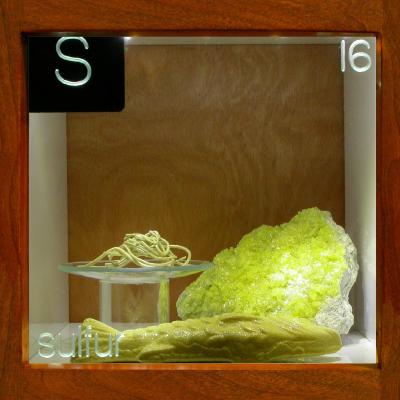Home Size: 1 2 3 4 5 6 7 8 9
|
 |
| A vivid yellow non-metal that exists in several forms, the most common being an amorphous yellow powder. It oxidizes readily with a pungent smell.
|
|
|
 |
Plastic sulfur.
This strange shape is what you get when you allow a think trickle of molten sulfur to fall into cold water. Watch the video to see this very piece being formed. Initially, the pasta like loops are easy to bend and this property gives rise to the name of this form of the element: plastic sulfur. However over time the solidified sulfur crystallized and becomes brittle, making this preserved shape very fragile.
Source: flowers of sulfur from chemical supplier
Size: 2"
Purity: 99.9%
|
|
 |
Fish.
Although sulfur is not a metal, it can be melted and cast just like one. In fact for a brief period in the 1800's molten-sulfur inlaid wood furniture was popular. This fish was cast out of low-grade gardening sulfur molten and poured into a non-stick cornbread mold.
Source: Soil sulfur
Size: 5"
Purity: >90%
|
|
 |
Native Sulfur.
Sulfur has been known since ancient times, its name stemming from the Latin sulfurium, itself possibly derived from the Sanskrit sulvere. It is most often associated with volcanic environments but also forms through the bacterial decomposition of sulfate deposits and the burning of coal deposits. Native sulfur takes many forms from beautiful gem-like transparent crystals to powdery crusts. This specimen is from the El Desierto Mine in Potosi Department, Bolivia. Sulfur occurs naturally in two distinct allotropes, orthorhombic sulfur (S8) and the much rarer monoclinic sulfur (S), known as rosickyite.
Source: Bolivia
Size: 3"
Purity: >95%
|
|

